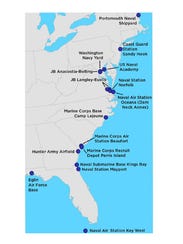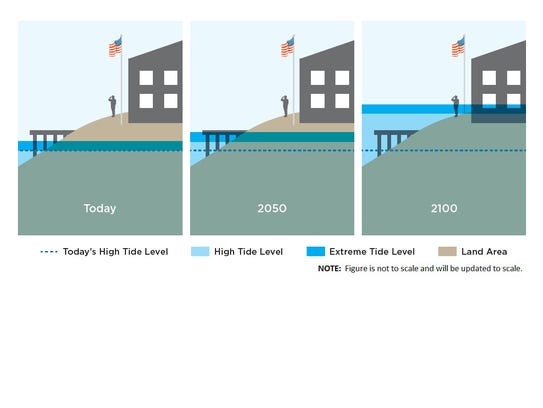
The guided missile destroyer USS Ramage, left, leaves port as sailors aboard the USS Porter prepare to depart Norfolk Naval Station in Norfolk, Va., Tuesday Sept. 16, 2003. The second fleet ordered 40 ships to sea to avoid the potential damage from Hurricane Isabel.(Photo: Steve Helber, Associated Press)
The Union of Concerned Scientists found that by 2050, half of the 18 East and Gulf Coast military installations it analyzed would experience 270 or more flood events per year — up from just 10 events annually today...
Four bases in Florida, Virginia and South Carolina could lose 20% or more of their land in the same time period, said Erika Spanger-Siegfried, lead author of the report, which used peer-reviewed scientific research and other projections to make the predictions.
"Military bases and personnel protect the country, often providing rescue services in dangerous floods and other natural disasters," the report states. "Our defense leadership has a special responsibility to protect the sites that hundreds of thousands of Americans depend on for their livelihoods and millions depend on for national security."

The bases studied spanned the East and Gulf Coast. (Photo: Union of Concerned Scientists)
Over the past century, sea level climbed a foot or more in some U.S. cities due to ocean currents and land subsidence, a gradual settling or sudden sinking of the Earth's surface due to underground movement of soil and dirt.
Scientists don't know exactly how much higher the waters will climb, but many project global sea level will rise about 1 foot to slightly more than 3 feet by 2100, according to the most recent assessment report by the United Nations' Intergovernmental Panel on Climate Change. NOAA predicts sea level could rise higher, by as much as 6½ feet, by century's end.
“The Pentagon knows it has a problem, and some bases are already making an effort to reduce their exposure,” Spanger-Siegfried said. Langley Air Force base near Hampton, Va., for example, is raising electrical equipment and installing flood barriers and pumps, among other efforts, she added.
Not all of the bases the environmental group analyzed responded to the report, but of those that did, Spanger-Siegfried said she was "surprised how much some places were so acutely aware of the issues."
“But there’s a big gap between what’s being done and what’s needed," she added.
Air Force Lt. Col. Eric Badger. a spokesman for the Pentagon, said the Defense Department was aware of the report but had no immediate comment.

As sea level rises, local flood conditions can happen more often, to a greater extent, and for longer time periods when extreme tides occur. And the daily high tide line can eventually begin to encompass new areas. (Photo: Union of Concerned Scientists)
To help do something about the climate change and global warming emergency, click here.
Sign up for our free Global Warming Blog by clicking here. (In your email, you will receive critical news, research, and the warning signs for the next global warming disaster.)
To share this blog post: Go to the Share button to the left below.

Be the first to comment
Sign in with